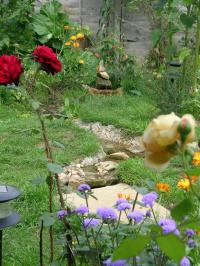Designing a Small Garden Water Feature
 Having a streamlet in your garden can provide a small piece a suburban tranquillity
Having a streamlet in your garden can provide a small piece a suburban tranquillityHaving small children does not necessarily preclude you from having a water feature in your garden, or even your own miniature babbling brook.
The original landscape theme and inspiration for my garden design was water, where I tried to create the effect of a cascading river by reshaping the lawn in my garden. Some months later though and with the influence of many a trip to other gardens, I decided to change tack and altered the look of my garden in a single day. I was very pleased with the new effect, which minimised lawn care and maximised forms and colours most pleasing to the eye.
The process started as I sat in my gazebo on a long hot summer day and was struck by the notion that the view lacked something.
The highest tier of my original landscaping was now an awkward rectangle of grass that did not do justice to the plants around it. So, having had a pond banned by the wife on child safety grounds, I decided that what would look ideal would be a small waterfall and stream.
There were three influences to this decision:
- Firstly, I have always found the sound of running water relaxing. It harks back to days walking in the hills of Wales.
- Secondly, when I was a child, I always wanted a stream to use as a backdrop to many a sophisticated Lego adventure and I wanted to provide just that for my youngest Lego crazy child.
- Thirdly, the movement provided by water caught by a shard of sunlight is matched only in my experience by the beauty of snow crystals glistening in the air on a sunny morning.
In creating my little water feature, geography lessons played a great part as I tried to recreate the meandering curves of a river with my spade in the turf. At the lower end, I dug a deep sump. It needed to contain enough volume of water so that when the pump inside it began to send its contents to the fountain at the top end of the feature, the water would flow back into the sump before it ran dry. I lined the feature in one mix of concrete from top to bottom, being careful to ensure that the depth was adequate to contain any build up in the depth of water in narrow parts. Stones were strategically placed before the concrete set to create rapids and smaller water falls.
I placed a 1,000 litre per hour pump into this sump and ran a hose up to the fountain, which I had made by simply piling some large sandstone in an interesting design, and wedged the hose end under one of these stones.
I covered the sump with a flag stone and turfed in the edges. The water would cascade down one fall, meander the length of the stream and cascade again, disappearing from view beneath the flag stone to be cycled back up to the top again.
Although there were some teething problems to do with water loss through splashes and backing up of the flow in some places, a little mental exertion soon put these right, and I and my Lego boy have had many satisfying hours by our very own stream. Iíve tried to improve the natural look by smearing the concrete with yoghurt. As yet, Iíve been unsuccessful!
I might add that a residual current device is an absolute must for any water feature powered by AC electricity. We want our kids (and the cat, who loves to crouch down and drink from the stream like a tiger in the jungle) to get a buzz for all the right reasons! I reused the old plastic armour for the house wiring to protect the pump wire.
You should be able to get an RCD and the pump for around £50. Thatís still cheaper than most of the standard water features you can get in garden centre. So why not have a go yourself?
This article was written by Joe Munford.
Filed under Garden Design.

